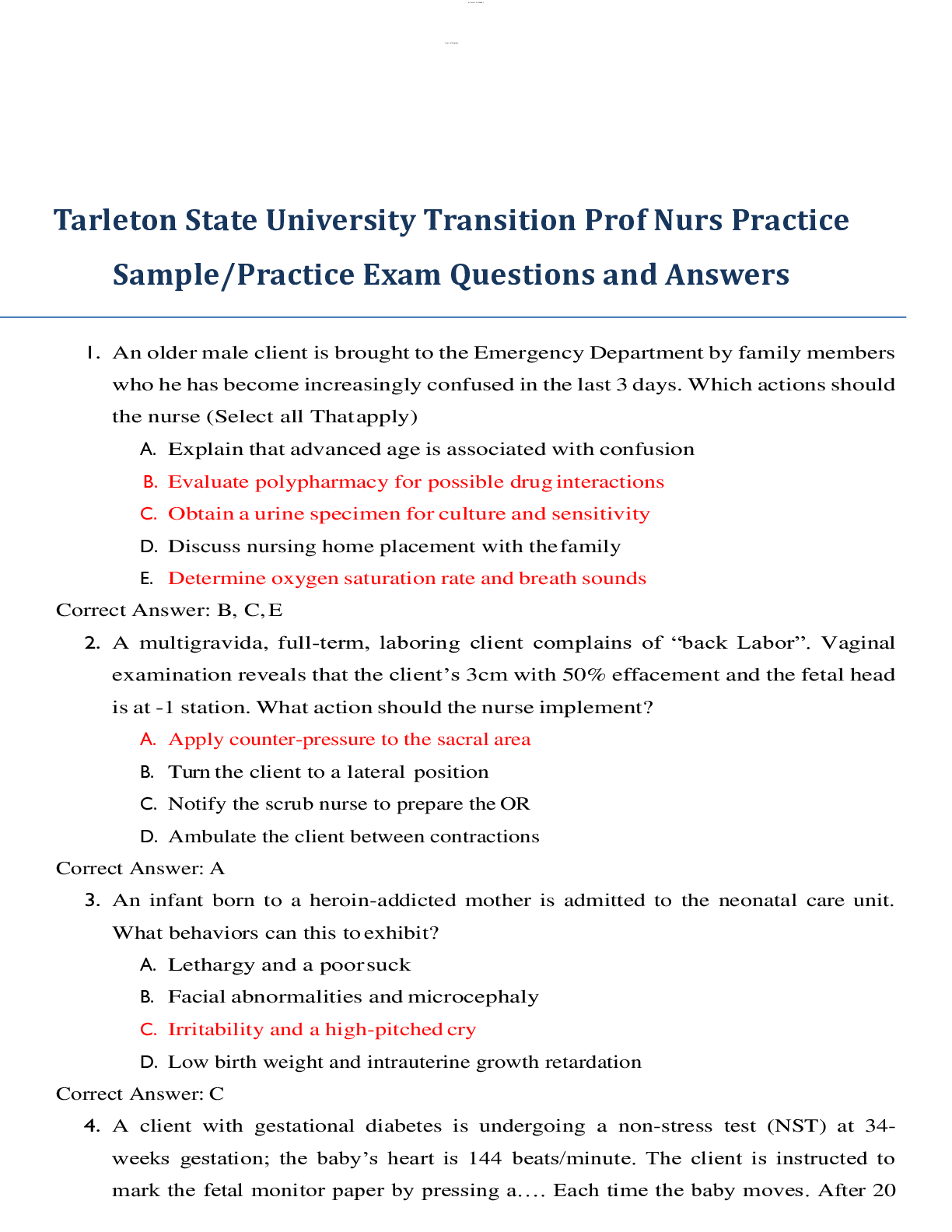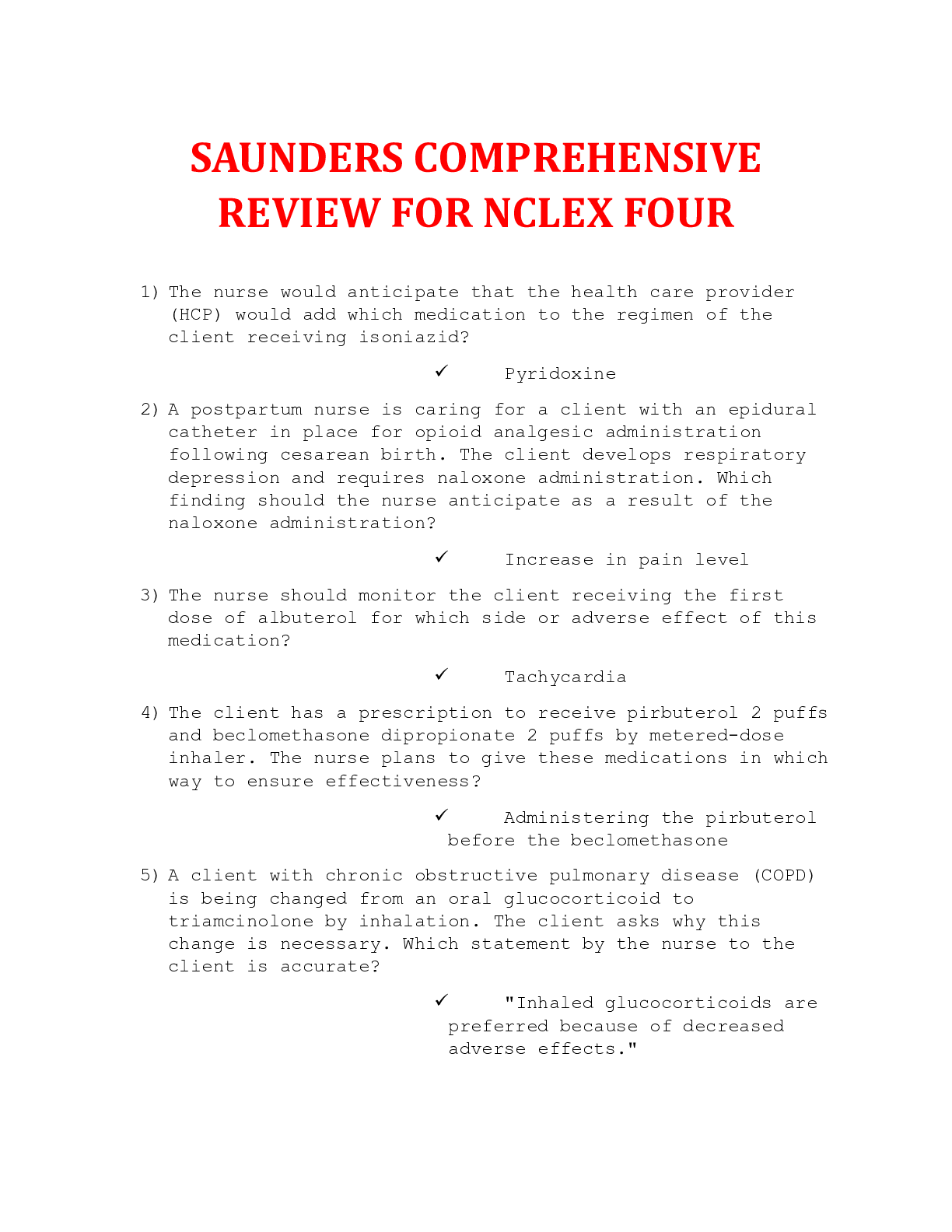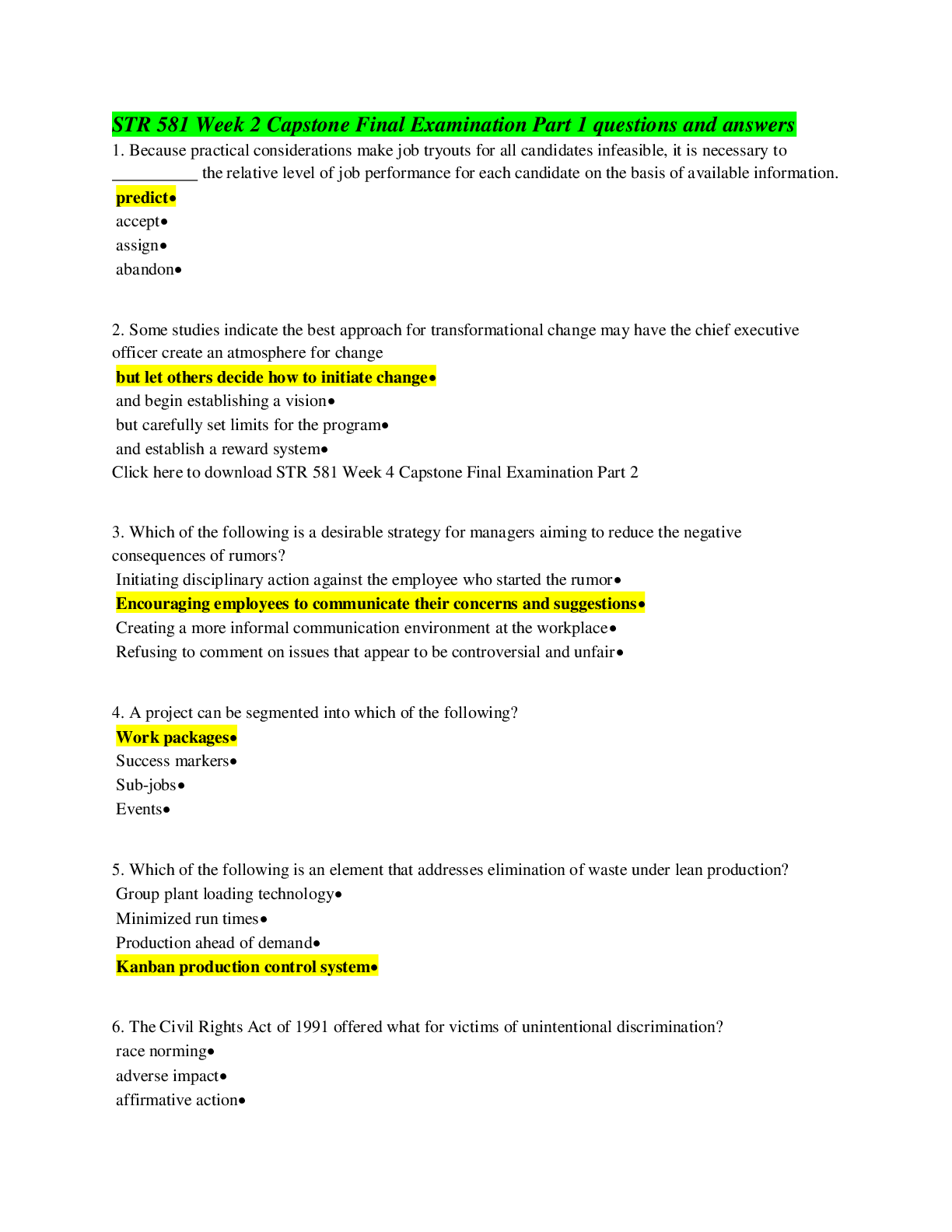*NURSING > QUESTIONS & ANSWERS > PATHO EXAM 1 Questions and answers, 2022 update, Graded A+ (All)
PATHO EXAM 1 Questions and answers, 2022 update, Graded A+
Document Content and Description Below
PATHO EXAM 1 Questions and answers, 2022 update, Graded A+ What are the functions of the cell membrane? - ✔✔Physical isolation (separates ECF from ICF) Controls regulation of exchange within... the environment Communication b/w the cell and its environment Structural Support What is the composition of the cell membrane? - ✔✔Mostly contains: Lipids, Proteins, However, does contain: Cholesterol, Phospholipids, Sphingo Lipids. The more metabolic activity within the cell membrane the more - ✔✔Proteins The Fluid Mosaic model ** ake the cell membrane What does it contain, what are the roles of those components? - ✔✔Phospholipids, Cholesterol and protein. Lipids are mostly phospholipids in a bilayer. The cell membrane is studded with proteins (extracellular surface glycoproteins and glycolipids) Cholesterol is important in the cell membrane.: they insert themselves b/w the phillic heads of the phospholipids and help them become impermeable to small water molecules. Keeps membranes flexible over wide range of temperatures. What are the different types of lipids within the cell membrane? - ✔✔Phospholipids Sphingolipids Cholesterol What do sphingolipids contain - ✔✔Fatty Acid tails but heads may be phospholipid or glycolipid Cholesterol is mostly: - ✔✔hydropohobic What are the different phospholipid structures in water solutions - ✔✔Bilayer of the cell membrane micelle liposome What are micelles? - ✔✔Small droplets with a single layer of phospholipids, interior is filled with hydrophobic fatty acid tails. What are liposomes? - ✔✔Large spheres with with bilayer phospholipid walls ( medium to deliver drugs) What are integral proteins? - ✔✔Transmembrane and lipid anchored proteins. Tightly bound to the membrane can only be removed by disrupting the membrane with detergents What are peripheral proteins? - ✔✔Attach to other membrane proteins via noncovalent interactions Transmembrane proteins - ✔✔protein chains extend all the way across the cell membrane What are the different Carbohydrates - ✔✔Glycoproteins Glycolipids Cell membranes permeability: - ✔✔Semipermeable What are lysosomes? - ✔✔small, storage like spherical organelles that contain the cell's digestive enzymes What is the mitochondria? - ✔✔Site of most ATP synthesis Double wall spherical organelles. Has an important role in cellular respiration What is the role of the Golgi apparatus? - ✔✔Contains hollow curved sacs Participates in PROTEIN modification and packaging into vesicles. What is the role of the rough ER? - ✔✔Contains rows of ribosomes attached. MAIN site of protein synthesis. What is the role of the smooth ER? - ✔✔Lacks ribosomes (that is why it is smooth). Synthesizes lipids, fatty acids, steroids and in some cells, stores and concentrates calcium ions. Modified forms in liver, kidney and muscles - helps inactivate drugs. What are ribosomes? - ✔✔tine structures where protein synthesis occurs (within rough er) What are centrosomes? - ✔✔Microtubule organizing center. Assembles tubulin monomers into microtubules What is cilia? - ✔✔Short hair like structures. Sweep fluid movement across cells surface. Moves secretions upwards, EX: once it comes to your throat you have the cough reflex to spit it out. EX: Cells lining the upper airways and part of the female reproductive tract What is flagella? EX: - ✔✔Long, thin whip-like structure that helps organisms move through moist or wet surroundings. Male sperm. What are motor proteins? - ✔✔helps white blood cells squeeze out of blood vessels What is myosin and actin? - ✔✔Protein that aids in muscle contraction What are kinesins and dyneins? - ✔✔Assist the movement of vesicles across microtubules Dyneins associate with the microtubule bundles of cilia and flagella to help create their whiplike motion. The nucleus contains - ✔✔DNA and is filled with chromatin What is the teleological approach? - ✔✔`xplains the PURPOSE or goal of the function. Explains WHY a specific function happens. Think of the song: TELL(eological) me why?! ex: Why do red blood cells transports oxygen? answer: bc cells need oxygen What is the mechanistic approach? - ✔✔Explains the PROCESS of mechanisms. Explains the HOW How do cells transport oxygen? Answer: Oxygen binds to hemoglobin inside red blood cells- thats HOW! It explains the process. PURPOSE OVER PROCESS - TELE/MECH What is the transitional process? - ✔✔Uses research findings APPLIES FUNCTION AND PROCESS ex: research found that a chemical from the pancreas ...their findings led them to conduct transitional research in which human volunteers..exct. What does physiology mean? - ✔✔The study of the normal function of a living organism and its component parts including all of its chemical and physical properties. What does PathoPhysiology mean? - ✔✔The disordered physiological processes associated with disease or injury What does immunity mean? - ✔✔The ability of the body to protect itself from pathogens What is homeostasis? - ✔✔The dynamic steady state, the stability of the body's internal environment: temp, PH, ion concentration, oxygen, water. When you FAIL to maintain homeostasis = causes disease and sickness a disequilibrium of the body What is a response loop? - ✔✔Stimulus--> sensor--> **input signal --> **integrating center --> **output signal --> target --> response. What is a negative feedback loop? - ✔✔A negative feedback system is homeostatic. Stabilizes variable. The response opposes or removes the original stimulus and the response loop is stopped. Initial stimulus--> response --> decrease in stimulus. Cannot prevent the change that triggered the reflex. EX: TEMP, BODY TEMP REGULATION What is a positive feedback loop? give an example plz :) - ✔✔A positive feedback system is not homeostatic. An outside factor is required to shut down the loop. Initial stimulus occurs --> causes response-->response cause increase in stimulus-->an OUTSIDE factor is added and goes back to the response and a loop will continue until an outside source shut's it off! Reinforces stimulus until outside factor shuts it down** Ex: Child birth. Once a baby is delivered, there is no more stimulus and response loop for oxcytocin stops What is feed forward control? - ✔✔Able to predict a change that is about to occur. An ANTICIPATING response. Reflex to sight, smell, or the thought of food. For example: If you place a steak in front of me, it is expected I will salivate. EX: Salivation, stomach HCL secretion What is a local control system? - ✔✔response is restricted to specific area it is taking place (why it is called local) (cell/tissue level) healing process begins immediately What is a reflex control? - ✔✔Long distance signaling (nervous system, endocrine or both) *When* does insulin peak? - ✔✔(such as after a meal ) when blood glucose levels increase , metabolism increases, ATP increases, Katp channels close, calcium channels open & beta cells release insulin by Ca2+ binding to exocytosis. glycolysis cycle occurs. What happens when glucagon peaks? - ✔✔stimulated by low blood glucose, protein-rich meals and adrenaline (another important hormone for combating low glucose). Alpha cells release glucagon, liver breaks down glycogen to glucose. *When* does cortisol peak? - ✔✔-steroid hormone when triggered can decrease stamina during the day and affect sleep. EARLY MORNING. Lowest in sleep What cells are commonly seen in acute inflammation? - ✔✔Exudation of fluid and plasma proteins and the migration of polymorphonuclear leukocytes, PRIMARILY neutrophils, to the site of injury. acute injuries-sudden onset, short duration. What cells are commonly seen in chronic inflammation? - ✔✔The predominant cells involved in a chronic inflammation are the lymphocytes and the macrophages. The inflammation does not resolve, but persists over time, or it can be defined as repeated episodes of acute inflammation! What cells are commonly seen in bacterial infections? - ✔✔Neutrophils What cells are commonly seen in allergic reactions? - ✔✔eosinphils What is an allergy? - ✔✔inflammatory response to the allergn What cells are commonly seen in viral infections? - ✔✔Lymphocytes Vasodilation is the role of which chemical mediators? - ✔✔histamine, bradykinin, Nitric Oxide (NO) and Prostaglandins (PG's) Vascular or "capillary" permeability is the role of which chemical mediators? - ✔✔Histamine, Complement system (CS), Platelet activating factors (PAF), Leukotrienes (LT), bradykinin Opsonization is the role of which chemical mediators? - ✔✔TNF- α Interleukins (ILS) What are opsonins? - ✔✔molecules that coat foreign material to make them more visible to immune cells What are natural killer cells?? - ✔✔Kill certain tumor cells and virus infected cells when they detect the absence of MHC proteins on the cells surface What are chemotaxins? - ✔✔attract immune cells to pathogens Chemotaxis is the role of which chemical mediators? - ✔✔TNF Interleukins (ILS) Fever is the role of which chemical mediators? - ✔✔TNF-α Interleukins (IL) -1 Prostaglandins (PG) Pain is the role of which chemical mediators? - ✔✔Kinins: bradykinin, PG, Substance P Tissue damage is the role of which chemical mediators? - ✔✔Complement system (CS) lysosomal enzymes EXTRA bradkinin Histamine lysosome interleukins - ✔✔bradkinin-vasodilator stimulates p! receptos Histamine-vasodilator and broncho restrictor, capillary permeability lysosome-attacks bacteria interleukins-mediates inflammatory responce induces fever What are the 5 types of exudates? - ✔✔Sanguineous Serous Serosanguinous Purulent Catarrhal What is an exudate? - ✔✔(fluid) deposits in nearby tissue due to inflammation What injury would you see a Sanguineous exudate occur? What is its role? - ✔✔Hematoma bloody drainage What is an example of Serous exudate? What is its role? - ✔✔Fluid filled blister, joint effusion thin, clear, watery fluid. It contains plasma proteins and immunoglobulins, and is very common in the early stages of most inflammations What is an example of Serosanguinous exudate? Explain its components. - ✔✔Serosanguinous is blood-tinged, so it's got the serous, which is the clear watery fluid, and a little bit of blood.-yellowish. Most common Where would you see Purulent exudate Explain its components. - ✔✔is viscous, cloudy, pussy, and that is filled with leukocytes and debris of dead cells. EX: Abscesses -which can evolve into a complication of inflammation. What infection would you see Catarrhal exudate occur? What is its role? - ✔✔Respiratory infection Mucous What are local infection/inflammation signs and symptoms? - ✔✔Rubor (redness) • Calor (heat) • Tumor (swelling) • Dolor (pain) • Functio laesa (Altered function of the tissue) What are the systemic infection/inflammation signs and symptoms? - ✔✔involves the entire body rather than a single organ or body part -Decreased appetite -Nausea -Fever -Malaise -Anemia -Weight loss -Weakness What is the role of fibronectin in tissue healing? - ✔✔o forms a scaffold to provide tensile strength o stabilizes the healing tissue o plasma - derived fibronectin binds fibrin o Is a chemotaxin (attracts) fibroblasts and macrophages to injury site. -fibroblasts secrete more fibronectin -binds to proteoglycans and collagens to further stabilize the healing tissue -important role in the synthesis of the extracellular matrix. What is the role of proteoglycans in tissue healing process? - ✔✔o Retains water and helps to hydrate tissue via carbohydrate chains and sugar -They contribute to the organization and stability of collagen Secreted by fibroblasts o Binds to fibronectin and collagen for stabilization What is the role of Elastin in tissue healing process? - ✔✔-Secreted by fibroblasts o Creates cross links to provide tissue elasticity What is the role of collagen in tissue healing process? - ✔✔-Provide structural support and tensile strength for almost all tissues and organs!! o 3 chains of amino acids coiled into a triple helix o Type 1 - tendons, and bones; mature scars (pale and flat) o Type 2 - cartilaginous tissue and growth plates o Type 3 - new scars (red and raised, fragile) What are the five different types of epithelial tissue? - ✔✔Exchange, Transporting, Ciliated, Protective, Secretory What is the location and role of the Exchange epithelial tissue? - ✔✔Location: Lungs, lining of blood vessels. Role:Pores b/w cells permit easy passage of molecules. 1 layer Flattened cells. What is the location and role of the Transporting epithelial tissue? - ✔✔Location: Intestine, kidney, digestive system & some exocrine glands. Role: Tight junctions prevent mvmt b/w cells; regulate the exchange of nongaseous materials such as ions and nutrients b/w internal and external environments. 1 cell layer Columnar or cuboidal What is the location and role of the Ciliated epithelial tissue? - ✔✔Location: Nose, trachea and upper airways; female reproductive tract. NOT in your lungs! Role: To move fluid across the surface if you smoke it paralyzes the ciliated epithelium of the respiratory tract -loss of ciliary function contributes to higher respiratory infection: when the mucus that traps the bacteria can no longer be swept out of the lungs by the cilia. EX: Filopian tubes: Helps to move the ovum into the uterus so that it can be fertilized ^^ If you have a sexually transmitted disease, it is doing damage to your cilia and cilia will not be able to move the sperm. So if your cilia is destroyed could be very bad! EX: Trachea and Bronchi: It helps to move microbes and debris out of the airways 1 cell layer columar or cuboidal What is the location and role of the Protective epithelial tissue? - ✔✔Location: Skin and lining of cavities (such as the mouth) that open to the environment., esophagus, vagina, pharynx, urethra. Role: Prevents exchange b/w internal and external environment and protects areas subject to mechanical or chemical stresses. many cell layers flattened in surface polygonal in deep layers What is the location and role of the Secretory epithelial tissue? - ✔✔Location: Exocrine glands, including: pancreas, sweat glands, and salivary glands; endocrine glands such as thyroid and gonads. AND Endocrine glands. - Contains extensive SER and RER Role: Produce a substance and secrete it into extracellular space. EXOcrine glands: release their secretion to the body's external environment: ex: skin serous and mucous (both are salivary)secretions, pancreas, sweat glands ENDOcrine glands: ductless & release their **hormones into the body's extracellular components. (estrogen and testosterone and cortisol) What are three types of cell junction? - ✔✔Gap or "communicating", Occluding or "tight", and Anchoring junctions. What is the function of a GAP or "communicating" junction, where would we see these? - ✔✔Rapid cell to cell communications. Contains transmembrane proteins called "connexins" create a passageway to allow chemical and electrical signals to pass from one cell to another. Muscle cells, nerve cells, liver, thyroid, intestinal tract, kidney, pancreas and ovary Channels are able to open and close What is the function of an Occluding or "TIGHT" Junction? - ✔✔Restrict the movement of material between linked cells Cell membranes partly fuse together (why it is called tight) by membrane proteins called claudins and occludins. Regulates what enters and leaves the body Found in: Intestinal tract, kidney, blood brain barrier What is the function of an Anchored junction? - ✔✔Strongest junction. Binds cells to cells or cells to the matrix VIA: CAM's (cell adhesion molecules)-cadherins or integrins If it is though Cadherins: Cell to Cell ANCHOR (just think C for cadherins and cell). There are two types of "cell to cell" anchoring junctions: -Adherens or Desmosomes Adherens: link actin fibers in adjacent cells together Desmosomes: attach to intermediate filaments of the cytoskeleton-STRONGEST CC junction Integrins-cell to matrix ANCHOR Two types of cell to matrix JUNCTIONS: Hemidesmisomes and Focal Adhesions For summary purposes What are the different CADHEREN cell to cell junctions? - ✔✔adheren junction-actin desmesomes-intermediate filament/strongest junction For summary purposes: What are the different INTEGREN cell to matrix junctions? - ✔✔hemidesmesomes focal adhesions What are centrioles? - ✔✔Direct DNA movement during cell division What are peroxisomes? - ✔✔Contain enzymes that break down fatty acids and some foreign materials. Cell membranes are (permeability) - ✔✔selectively permeable or semi permeable exchange b/w intracellular and extracellular compartments is restricted. -Two properties influence movement across cell membranes: lipid solubility and size of molecule [Show More]
Last updated: 2 years ago
Preview 1 out of 37 pages

Buy this document to get the full access instantly
Instant Download Access after purchase
Buy NowInstant download
We Accept:

Reviews( 0 )
$12.00
Can't find what you want? Try our AI powered Search
Document information
Connected school, study & course
About the document
Uploaded On
Aug 23, 2022
Number of pages
37
Written in
Seller

Reviews Received
Additional information
This document has been written for:
Uploaded
Aug 23, 2022
Downloads
0
Views
120


















, 100% Correct, Download to Score A.png)






